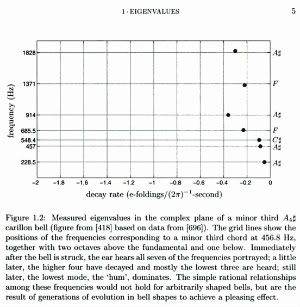Showing posts with label sound. Show all posts
Showing posts with label sound. Show all posts
Saturday, May 8, 2010
Frequency components of music
From Spectra and Pseudospectra; click for full size.
Measured eigenvalues in the complex plane of a minor third A4# carillon bell. The grid lines show the positions of the frequencies corresponding to a minor third chord at 456.8 Hz. together with two octaves above the fundamental and one below. Immediately after the bell is struck, the ear hears all seven of the frequencies portrayed; a little later, the higher four have decayed and mostly the lowest three are heard; still later, the lowest mode, the 'hum', dominates. The simple rational relationships among these frequencies would not hold for arbitrarily shaped bells, but are the result of generations of evolution in bell shapes to achieve a pleasing effect.
Seems like this format could make a nice interface for designing new sounds; someday I'd like to get around to recreating it.
Monday, April 12, 2010
Bicycle Built for Two Thousand
Bicycle Built For 2,000 is comprised of 2,088 voice recordings collected via Amazon's Mechanical Turk web service. Workers were prompted to listen to a short sound clip, then record themselves imitating what they heard. (more info)
(Daisy Bell was famously performed by an IBM 704 in 1962, in the world's first example of musical speech synthesis-- which is probably why Kubrick chose it for the end of 2001 as well.)
(Daisy Bell was famously performed by an IBM 704 in 1962, in the world's first example of musical speech synthesis-- which is probably why Kubrick chose it for the end of 2001 as well.)
Labels:
culture,
sound,
technology
Sunday, November 22, 2009
Delia Derbyshire, Alchemist of Sound
The amazing Delia Derbyshire, pioneer of British electronic music, demonstrating tape loops. A clip from the documentary "Alchemists of Sound" on the history of the BBC Radiophonics Workshop, where Derbyshire worked from 1962-1973.
Derbyshire is best known for her realization of the original Doctor Who theme-- from Wikipedia: Derbyshire's interpretation of Grainer's theme used electronic oscillators and magnetic audio tape editing (including tape loops and reverse tape effects) to create an eerie and unearthly sound that was quite unlike anything that had been heard before. Derbyshire's original Doctor Who theme is one of the first television themes to be created and produced by entirely electronic means. Much of the Doctor Who theme was constructed by recording the individual notes from electronic sources one by one onto magnetic tape, cutting the tape with a razor blade to get individual notes on little pieces of tape a few centimetres long and sticking all the pieces of tape back together one by one to make up the tune. This was a laborious process which took weeks.
From her web site: A recent Guardian article called her 'the unsung heroine of British electronic music', probably because of the way her infectious enthusiasm subtly cross-pollinated the minds of many creative people. She had exploratory encounters with Paul McCartney, Karlheinz Stockhausen, George Martin, Pink Floyd, Brian Jones, Anthony Newley, Ringo Starr and Harry Nilsson.
Labels:
music,
sound,
technology,
videos
Saturday, July 4, 2009
Spectrogram to Sound
I'm still vaguely searching for a good free spectrogram-to-sound program, but this Sound to Graph to Sound Java applet is a good start.
The default resolution is pretty low, but if you're not interested in any of their demo sounds and just feel like doodling, you can hit the reset button to adjust some of the parameters. You can increase the resolution to MxN = 448x448, and to get the frequency bounds closer to vocal range I'd set FL to 10, keeping FH at 4000 (or possibly changing to 8000). You can also increase the value of NFRAME, which lets you store multiple sounds which you can navigate through with the arrow keys, or check the animate box to play them in sequence.
Mostly so far I have succeeded in making lots of drawings that all sound like frogs. Curious.
The default resolution is pretty low, but if you're not interested in any of their demo sounds and just feel like doodling, you can hit the reset button to adjust some of the parameters. You can increase the resolution to MxN = 448x448, and to get the frequency bounds closer to vocal range I'd set FL to 10, keeping FH at 4000 (or possibly changing to 8000). You can also increase the value of NFRAME, which lets you store multiple sounds which you can navigate through with the arrow keys, or check the animate box to play them in sequence.
Mostly so far I have succeeded in making lots of drawings that all sound like frogs. Curious.
Subscribe to:
Posts (Atom)
